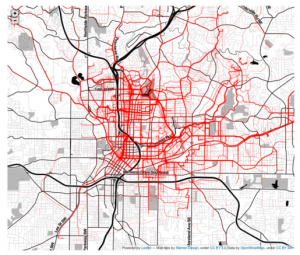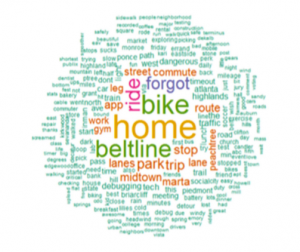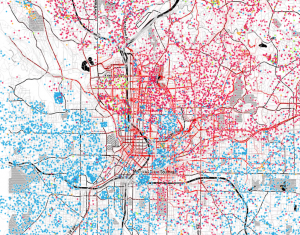Rhetoric and Representation in Transportation Planning: A Data With Destiny
What power does crowdsourced data have in the shaping of plans? Through conducting ethnographic fieldwork during a three-day urban planning event referred to as a ‘charette’, the opportunity arose for La Dantec et al. [1] to explore how professional planners make sense of emerging forms for public participation in planning processes such as Browns’ SpeedBump [2] and Gordon and Schirra’s Participatory ChinaTown [3]. Printed maps [Figures 1, 2] highlighted target corridors of activity derived from ‘raw’ data (not been normalised or ‘cleaned’ for duplicate trips) and a word cloud, humanising the ‘hard’ data of the geographic particularities of the city by connecting the data to the agency and the intent of those collecting it.

During the event the geo-location data of 535 cyclists and 5386 rides using the smartphone application ‘Cycle Atlanta’, Dantec and co. observed that through interactions between planners and participants that data took on different roles and purposes depending on context. Tensions initially arose upon the understanding that ‘data’ as a concept was not homogenous; many sources of data were used and referred to, influencing debate and discussions in a variety of different ways.

Through use of these representations of data, Le Dantec smartly distinguishes from the collected data three discursive roles;
Data as authority: derived from technical origins, afforded rhetorical weight both to specific points of discussion and overall process.
Planner 1: I mean, are people coming off of 10th to skip that section? Planner 2: Yeah, they’re all using 12th
Assistant Director: If you look at the Cycle Atlanta data, they’re all using 12th [showing and gesturing to the map]
Data as evidence: supporting legitimacy of data, mutable role of evidence-as-visibility – corroborate and validate existing points of view.
Assistant Director: I like to see all these people on Peachtree ’cause that means when we put facilities on Juniper and Piedmont, I think we’re gonna see a lot of people using it.
Data as ambivalent: rather than outright dismissal of data, can serve to support conflicting arguments, embodied “paradoxical roles simultaneously”.
Planner 1: That looks like the strongest corridor.
Assistant Director: Well, again though, that’s Georgia Tech, a lotta the people using the app are at Georgia Tech. It is one of the busiest corridors in the city
Through use of the two representations of data, engaging “multiple, polysemic voices” [1] that le Dantec claims that the two “authentically mirror participants” contradicting and complex opinions” [1]. However, I must ask at this point whether data truly act as a surrogate for direct participation in the planning process? Data without the humanising elements of purpose, agency and sensory experience can be shaped and moulded to fit a seemingly contradictory point held by the original contributor of data. Although it is possible for participants to hold contradictory views at one time, would this be typical behaviour from a participant in a discussion? When le Dantec discusses the first role data takes on, I believe he’s missed stating something rather important; raw data alone cannot in itself act as an authority. This role requires agency of enforcing power over someone; therefore provides authority to an individual who can exert authority over others with the understanding. Individuals who can format and interpret the data therefore have greater authority over those who do not or cannot. Despite this minor criticism, the paper’s conclusions are pithy and well-considered with the issue of diversity, albeit brief providing the most interest for me as it leads to a discussion of the consequences of using ‘objective’ data from a particular ethnicity, an under-represented or ignored section of society.

From Fig. 3 with Blue representing individuals racialised as black and Red representing individuals racialised as white the data becomes more interesting; could the lack of data be a deliberate dismissal of Cycle Atlanta or a deliberate exclusion? Le Dantec’s paper incited exciting questions that must always be asked within any data-driven project; who is this data representing, why is it being used and how will it be formatted?
Last week’s HCI class saw the unfolding and scrutiny of experience-centred design to which my group was tasked with examining and presenting McCarthy and Wright’s paper the “Dialogical Approach to the Experience”. I was delighted to read the narration by Martin Jay [4] on the ambiguity tied up with the use of the word ‘experience’ having experienced this within my UG philosophy degree whereby rationalists, empiricists and phenomenologists fought tooth and claw to provide the ‘true’ meaning of the word. As time ran too short for a question for this paper to be asked, Sebastian brought up a question of his own that warrants discussion; how if experience is to be unrestricted can designers produce an experience-designed artefact? In this a power balance shifts from the designer and researcher towards the participant whereby their understanding and outlook shape and determine the end process aiming to emulate design by the individual rather than for the individual. Care must be installed with any talk of experience as too specific a definition falls into determinism, too vague and the project can fall into abstraction and obscurity.
[1] Le Dantec, C, A; Asad, M; Misra, A; Watkins, K, E; ‘Planning with Crowdsourced Data: Rhetoric and Representation in Transportation Planning’ (2015) CSCW ’15 Proceedings of the 18th ACM Conference on Computer Supported Cooperative Work & Social Computing, pp. 1717-1727, URL: http://dl.acm.org/citation.cfm?id=2675212
[2] Brown, M. ‘“Street Bump” Android app detects and reports potholes‘ (2011) Wired.co.uk, URL: http://www.wired.co.uk/news/archive/2011- 02/14/street-bump-app.
[3] Gordon, E. and Schirra, S. ‘Playing With Empathy: Digital Role-Playing Games in Public Meetings’ (2011) Proceeding C&T ’11 Proceedings of the 5th International Conference on Communities and Technologies, pp. 179-185, URL: http://dl.acm.org/citation.cfm?id=2103378
[4] Jay, M ‘Songs of Experience’ (2005) Berkley, University of California Press, p.12, URL: http://www.ucpress.edu/book.php?isbn=9780520248236
Leave a Reply Cancel reply